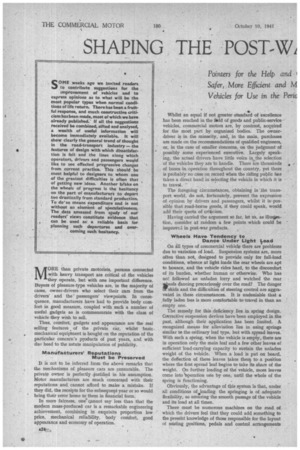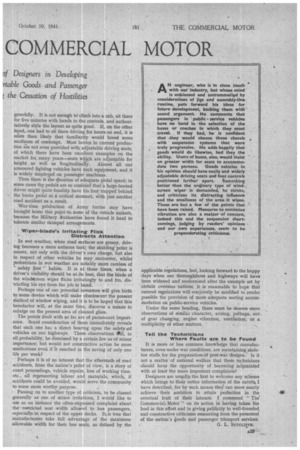SHAPING THE POST-WI COMMERCIAL MOTOR
Page 26

Page 27

If you've noticed an error in this article please click here to report it so we can fix it.
MORE than private motorists, persons connected with heavy transport are critical of the vehicles they operate, but with one important difference. Buyers of pleasure-type vehicles are, in the majority of cases, owner-drivers who select their cars from the drivers and the passengers' viewpoints. In consequence, manufacturers have had to provide body comfort in good measure, coupled with such a number of useful gadgets as is commensurate with the class of vehicle they wish to sell.
Thus, comfort, gadgets and appearance are the real selling features . of the private car, whilst basic mechanical equipment is bought on the reputation of the particular concern's products of past years, and with due heed to the astute manipulation of publicity.
Manufacturers' Reputations Must be Preserved
It is not to be inferred from the above remarks that the mechanisms of pleasure cars are censurable. The private owner is perfectly justified in his assumption. Motor manufacturers are much concerned with their reputations and cannot afford to make a mistake. If they did, the receipts for the subsequent year or so would bring their error home to them in financial form.
In mere fairness, one cannot say less than that the modern mass-produced ear is a remarkable engineering achievement, combining in exquisite proportion low price, mechanical reliability, body comfort, good appearance and economy of operation. . Whilst an equal if not greater standard of excellence has been reached in the field of goods and public-service vehicles, commercial motors are, by contrast, acquired for the most part by organized bodies. The ownerdriver is in the minority, and, in the main, purchases are made on the recommendations of qualified engineers, or, in the case of smaller concerns, on the judgment of possibly some experienced executive. Largely speaking, the actual drivers have little voice in the selection of the vehicles they are to handle. There are thousands of buses in operation throughout the country, yet there is probably no case on record when the riding public has taken a direct hand in selecting the vehicle in which it is to travel.
The foregoing circumstances, obtaining in the transport world, do not, fortunately, prevent the expression of opinion by drivers and passengers, whilst it is-possible that road-borne goods, if they could speak, would add their quota of criticism.
Having carried the argument so far, let us, as illuspation, consider at random a few points which could be improvel in post-war products.
Wheels Have Tendency to Dance Under Light Load
On all types of commercial vehicle there are problems due to variation of load. Suspension systems are, more often than not, designed to provide only for full-load conditions, whence at light loads the rear wheels are apt to bounce, and the vehicle rides hard, to the discomfort of its burden, whether human or otherwise. Who has not followed an unladen lorry and watched the rear libeels dancing precariously over the road? The danger 81f skids and the difficulties of steering control are aggravated in these circumstances. It is undeniable that a fully laden bus is more comfortable to-travel in than an empty one.
The remedy for this deficiency lies in spring design. Corrective suspension devices have been employed in the past, although their application has been limited. A recognized means for alleviation lies in using springs similar te the ordinary leaf type, but with spread leaves. With such a spring, when the vehicle is empty,. there are in operation only the main leaf and a few other leaves of sufficient load-carrying capacity to sustain the unladen weight of the vehicle. When a load is put on board, the deflection of these leaves takes them to a. position where the first spread leaf begins to take its share of the weight. On further loading of the vehicle, more leaves come into bperation one by one, until the whole of the spring is functioning.
Obviously, the advantage of this system is that, under all conditions of ...loading the springing is of adequate flexibility, so ensuring the smooth passage of the vehicle and its load at all times.
There must be numerous machines on the road of which the drivers feel that they could add something to the present knowledge of those responsible for the layout ot seating positions, pedals and control arrangements
generally. It is not enough to climb into a cab, sit there for five minutes with bands to the controls, and authoritatively style the layout as quite good. .If, on the other hand, one had to sit there driving for hours on end, it is more than likely that familiarity would breed some modicum of contempt. Most lorries in current production are not even provided with adjustable driving seats, of which there have been excellent examples on the market for, many years—seats which are adjustable for height as well as longitudinally. Almost all our armoured fighting vehicles have such equipment, and it is widely imployied on passenger machines.
Then there is the question of adequate pedal space; in some cases the pedals are so confined that a large-booted driver might quite feasibly have his foot trapped behind. the brake pedal at a critical moment, with just another road accident as a result.
War-time production of Army lorries may have brought home this plaint to. some of the vehicle makers, because the Military Authorities havefound it hard to tolerate similar skimped arrangements.
Wiper-blade's irritating Flick
Distracts Attention
In wet weather, when road surfaces are greasy, driving becomes a more arduous task; the skidding point is nearer, net only with the driver's own charge, but also in respect of other vehicles he may _encounter, whilst pedestrians in wet weather are notably more careless of " safety first" habits. It is at these times, when a driver's visibility should be at its best, that the blade of the windscreen wiper flicks irritatingly to and fro, distracting his eye from the job in hand.
Perhaps one of our potential inventors will give birth to some device which will make obsolescent the present Method of window wiping, and it is to be hoped that this benefactor will, at the same time, discover a means to enlatge on the present area of cleaned glass.
The points dealt with so far are of paramount importance. Scant consideration of them immediately reveals that each one ha.; a direct bearing upon the safety .of vehicles on our highways. These observations All, in all probability, be dismissed by a certain few as of minor importance; but would not constructive action be more meritorious even if it resulted in the saving of only one life per week?
Perhaps it is of no interest that the aftermath of road accidents, from the nation's point of view, is a story of court proceedings, vehicle repairs, loss of working time, etc., all representing labour and materials, which, if accidents could be avoided, would serve the community to some more worthy purpose.
Passing on to another type of criticism., to be classed generally as one of minor irritations, I would like to use as an instance the often-expressed complaint about the restricted seat width allowed to bus passengers, especially. in respect of the upper decks. It,is true that manufacturers take full advantage of the maximum allowable width for their bus seats, as defined by the
applicable regulations, but, looking forward to the happy days when our thoroughfares and highways will have been widened and modernized after the example set by certain overseas nations, it is reasonable to hope that current regulations will, conjointly be modified to render possible the provision of more adequate seating accom modation on public-service vehicles. •
Under the same heading, there must be dozens more observations of similar character, arising, perhaps, out of gear changing, engine vibration, ventilation, or a multiplicity of other matters.
Tell the Technicians
Where Faults are to be Found It is more or less common knowledge that manufacturers, even under war conditions, are maintaining skeleton staffs for the preparation+ of post-war designs. Is it not a matter of national welfare that these technicians should have the opportunity of becoming acquainted with at least the more important complaints?
Designers are usually the first to welcome any scheme which brings to their notice information of the natuYa I have described, for by such means the can more nearly achieve their ambition to attain perfection in the eventual fruit of their labours. I commend " The' Commercial, Motor " on its action in having taken the lead in this effort and in giving publicity to well4ounded and constructive criticisms emanating from the personnel of the nation's goods and passenger transport services.
G. L. SUTCLIVE.




















































